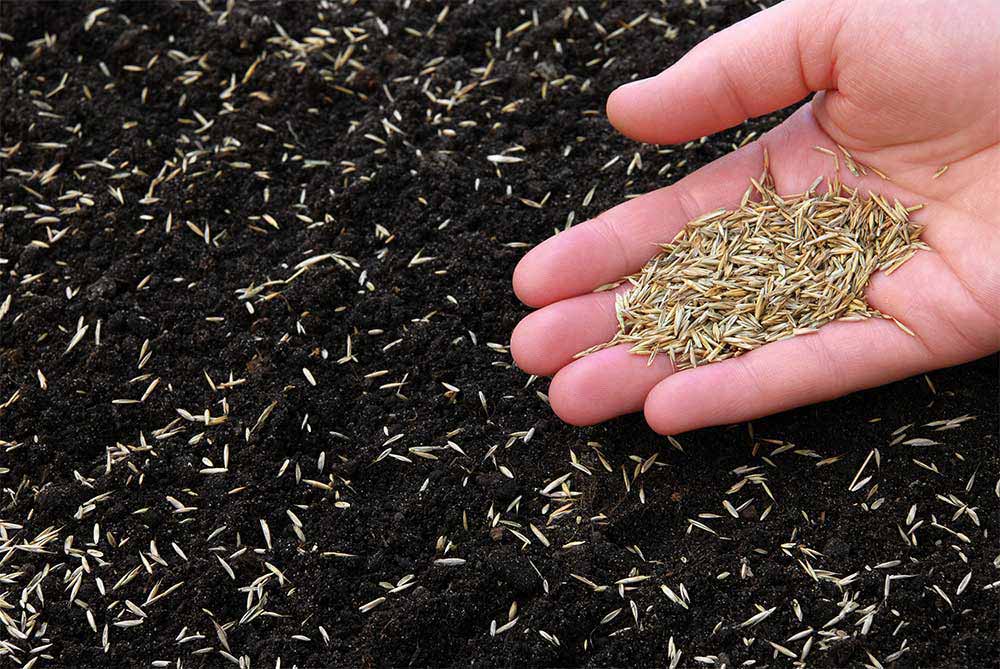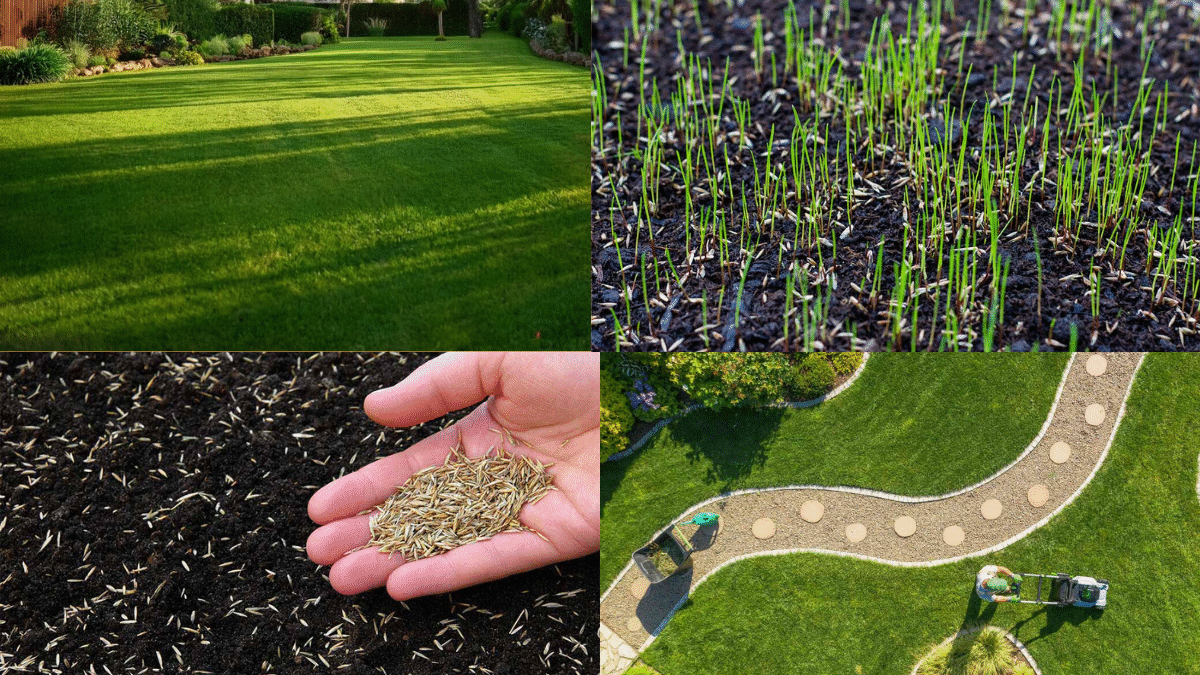There’s nothing quite like the look and feel of a thick, lush, green lawn. Whether you’re starting from scratch or repairing patchy spots, planting grass seed is a cost-effective and satisfying way to transform your outdoor space. But to achieve that perfectly carpeted look, you need to follow the right steps. In this guide, we’ll walk you through everything you need to know about how to plant grass seed for a lush, green lawn — from choosing the best seed to caring for your growing grass.

Why Choose Grass Seed Over Sod?
Many homeowners debate between grass seed and sod, but grass seed offers several clear advantages:
- Cost-effective: Grass seed is much more affordable than sod.
- Greater variety: More options in terms of grass type suited to your region and lawn use.
- Stronger, longer-lasting lawns: Seed-grown lawns often establish deeper roots, making them more resilient.
- Flexible application: You can seed an entire lawn or fill in bare patches as needed.
Choosing the Right Grass Seed
The first step to a thriving lawn is selecting the right type of grass seed for your climate, sunlight conditions, and intended lawn use. Grasses fall into two primary categories:
1. Cool-Season Grasses
Ideal for northern regions where temperatures range from cool to moderate.
Popular types:
- Kentucky Bluegrass
- Perennial Ryegrass
- Fine Fescue
- Tall Fescue
2. Warm-Season Grasses
Best for southern and transitional zones with hot summers and mild winters.
Popular types:
- Bermuda Grass
- Zoysia Grass
- St. Augustine Grass
- Centipede Grass
Pro tip: Check your USDA hardiness zone or consult local extension services for recommendations on the best grass varieties for your area.

When to Plant Grass Seed
Timing your seeding correctly is essential for optimal germination and healthy growth.
For cool-season grasses:
- Early fall is ideal (late August to mid-October), when temperatures are moderate and soil is still warm.
- Spring is also possible, but competition with weeds increases.
For warm-season grasses:
- Late spring to early summer is best, when soil temperatures consistently stay above 65°F.
Preparing the Soil for Planting
Successful grass seed growth starts with good soil preparation. Follow these essential steps before sowing your seed:
1. Test the Soil
A soil test will tell you the pH and nutrient levels. Grass thrives in soil with a pH between 6.0 and 7.0. Amend with lime (to raise pH) or sulfur (to lower pH) as needed.
2. Remove Weeds and Debris
Use a rake or dethatcher to clear away existing weeds, rocks, sticks, and dead grass.
3. Loosen the Soil
Till or aerate the soil to a depth of 2–3 inches to improve drainage and seed-to-soil contact.
4. Level and Grade
Rake the soil surface to ensure it’s even, removing high and low spots that might cause water pooling or dry patches.
5. Apply Starter Fertilizer
Use a starter fertilizer high in phosphorus (the middle number on the label) to promote root development.
How to Plant Grass Seed Step-by-Step
Now that your soil is ready, it’s time to get those seeds in the ground.
Step 1: Choose the Right Seeding Rate
Check your seed bag for recommended application rates — usually given in pounds per 1,000 square feet.
Step 2: Use a Seed Spreader
For even coverage, use a broadcast or drop spreader. Seed half the amount in one direction (north-south) and the other half in the opposite direction (east-west) for thorough, overlapping coverage.
Step 3: Rake Lightly
Gently rake the soil to cover the seeds with 1/8 to 1/4 inch of soil. Too deep, and seeds won’t germinate; too shallow, and they may dry out.
Step 4: Apply a Thin Mulch
Cover the seeded area with a light layer of straw, peat moss, or specialized seed mulch. This retains moisture, prevents erosion, and deters birds from eating the seeds.

Watering New Grass Seed
Proper watering is vital for seed germination and healthy root development.
Watering schedule:
- Keep the top 1 inch of soil consistently moist until seeds germinate.
- Water lightly 2–3 times daily in early stages.
- As seedlings grow, reduce watering frequency but increase depth to encourage deep root growth.
Pro tip: Avoid puddling and runoff, which can wash away seeds.
Grass Seed Germination Times
Different grass types have different germination rates. Here’s a quick guide:
| Grass Type | Germination Time |
|---|---|
| Kentucky Bluegrass | 14–30 days |
| Perennial Ryegrass | 5–10 days |
| Fine Fescue | 7–14 days |
| Tall Fescue | 7–12 days |
| Bermuda Grass | 7–21 days |
| Zoysia Grass | 14–21 days |
Lawn Care After Germination
Once your grass begins to grow, caring for it properly ensures it fills in thick and lush.
1. Mowing
Wait until grass reaches about 3 inches tall before mowing. Remove only the top 1/3 of the blade height to avoid stressing young grass.
Tip: Keep mower blades sharp to prevent tearing the tender grass blades.
2. Fertilizing
After the first 4–6 weeks, apply a balanced lawn fertilizer to maintain healthy growth. Avoid over-fertilizing, which can burn new grass.
3. Weed Control
Avoid using herbicides until your lawn has been mowed at least 3–4 times. Premature weed control products can harm young grass.
4. Continue Watering
Keep watering consistently, gradually reducing frequency as the lawn matures, but increasing the depth of each watering to promote strong root systems.

Common Mistakes to Avoid
For a lush, green lawn, steer clear of these common seeding errors:
- Skipping soil testing: Leads to poor germination and nutrient deficiencies.
- Seeding at the wrong time: Can result in weak or failed lawns.
- Overseeding or underseeding: Causes patchy, uneven growth.
- Burying seeds too deep: Delays or prevents germination.
- Inconsistent watering: Can dry out seeds or cause rot.
- Mowing too soon or too low: Damages tender, young grass.
Overseeding for a Thicker Lawn
If your existing lawn looks thin or patchy, overseeding can revitalize it without a full renovation.
Steps for overseeding:
- Mow your existing lawn low (about 1–1.5 inches).
- Rake and dethatch to remove debris and loosen soil.
- Spread grass seed evenly.
- Water regularly and avoid mowing until new grass reaches 3 inches.
Final Thoughts
Planting grass seed is one of the most effective and affordable ways to create a beautiful, thick, and healthy lawn. With the right preparation, seed selection, timing, and aftercare, you can turn bare soil or a patchy yard into a vibrant green oasis.
By following this step-by-step guide, you’ll not only enjoy the satisfaction of watching your lawn come to life but also reap the benefits of a lush, inviting outdoor space for years to come.





Leave A Comment